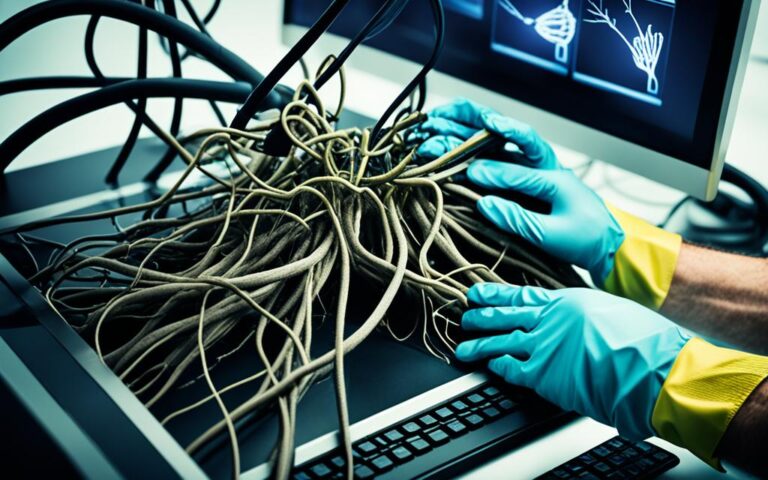Malicious Software Removal: Best Practices for Internet Users
Internet User Safety is of paramount importance in today’s digital landscape. With the increasing prevalence of Malicious software, or malware, it is crucial for internet users to understand the best practices for its removal. Malware refers to various code variants developed by cyber attackers to cause deliberate damage to computer systems or networks. It poses a significant threat to the security of personal and sensitive information.
Malware attacks have seen a staggering increase in recent years, with a drastic 86.38% rise from 2017 to 2018 alone. The types of malware that internet users need to be wary of in 2022 include ransomware, viruses, worms, bots, keyloggers, and trojans. These malicious programs can infiltrate systems, compromise data, and disrupt operations, leading to financial losses and reputational damage.
To protect against malware attacks, internet users must adopt and follow best practices for removal. This includes isolating infected systems, quarantining removable media, using safe mode, closing malicious programs, cleaning temporary files, running anti-malware scans, and crucially, keeping security software up to date. By implementing these practices, internet users can effectively mitigate the risks posed by malware and safeguard their digital lives.
What is Malware and How Does it Penetrate Systems?
Malware, short for malicious software, is designed to disrupt the operations of computer systems or networks and gain unauthorized access. It can be introduced to systems through various means, such as email attachments, links, downloaded software from untrusted sources, or infected external devices. Once malware is executed, it can cause damage, steal data, or gain remote control of the infected systems. Malware can be classified into different types, including ransomware, viruses, worms, bots, keyloggers, and trojans. Understanding how malware penetrates systems is crucial for implementing effective protection measures.
Methods of Malware Penetration
Malware can infiltrate computer systems and networks using different methods, taking advantage of system vulnerabilities or unsuspecting user actions. Here are some common penetration methods:
- Email attachments: Malicious actors often send emails containing infected attachments disguised as legitimate files. When unsuspecting users open or download these attachments, the malware is executed.
- Links: Malware can be distributed through deceptive links that lead users to malicious websites or initiate the download of infected files.
- Untrusted downloads: Downloading software or files from untrusted sources increases the risk of malware infection. Illegitimate websites or peer-to-peer networks may distribute infected files disguised as legitimate software.
- Infected external devices: Connecting infected external devices, such as USB drives or external hard drives, to a system can automatically install malware without the user’s knowledge.
System Vulnerabilities Exploited by Malware
Malware takes advantage of various system vulnerabilities to gain unauthorized access and execute its malicious activities. Some common vulnerabilities include:
- Outdated software: Failure to update software applications and operating systems leaves them susceptible to known vulnerabilities that malware can exploit.
- Weak passwords: Inadequate password strength makes it easier for malware to gain unauthorized access to systems or user accounts.
- Unpatched security flaws: Delaying or ignoring security patches leaves systems vulnerable to known vulnerabilities that malware can exploit.
- Phishing attacks: Social engineering techniques, such as phishing emails or deceptive websites, trick users into revealing sensitive information or executing malware.
By understanding the methods of malware penetration and the vulnerabilities it exploits, individuals and organizations can implement effective protection measures to safeguard their systems and data.
| Malware Type | Description |
|---|---|
| Ransomware | Malware that encrypts files and demands a ransom for their release. |
| Virus | Malware that replicates itself and can corrupt files or steal personal information. |
| Worm | Malware that spreads through networks and can cause widespread damage. |
| Bot | Malware used to assume control of systems and perform malicious activities. |
| Keylogger | Malware that tracks keystrokes to steal sensitive data. |
| Trojan | Malware that disguises itself as legitimate software but contains hidden malicious code. |
Types of Malware in 2022
In 2022, internet users need to be aware of various types of malware that can pose significant threats to their online security. Understanding these types of malware is crucial for implementing effective countermeasures and protecting sensitive data.
Ransomware: Ransomware is an extremely dangerous form of malware that encrypts files and holds them hostage, demanding a ransom for their release. Victims of ransomware attacks often face the difficult decision of either paying the ransom or losing access to their important files.
Viruses: Viruses are one of the most well-known and widespread types of malware. They replicate themselves and can corrupt files, disrupt system operations, and even steal personal information. Viruses can spread through various means, such as email attachments, infected software downloads, or compromised websites.
Worms: Worms are a type of malware that can spread across networks and exploit vulnerabilities in various systems. They can cause significant damage by consuming network bandwidth, slowing down systems, and even compromising sensitive data. Worms often spread through email attachments or network shares.
Bots: Bots, also known as “zombie computers,” are malware-infected devices that are under the control of a remote attacker. These bots can be used to perform malicious activities, such as launching distributed denial-of-service (DDoS) attacks, spreading spam, or mining cryptocurrencies. Bots are often created through the infection of vulnerable devices.
Keyloggers: Keyloggers are a type of malware that silently track and record keystrokes made on a compromised device. This allows malicious actors to capture sensitive information such as login credentials, credit card numbers, or other personal data. Keyloggers can be introduced through infected email attachments or malicious software downloads.
Trojans: Trojans are malware that masquerade as legitimate software or files but contain hidden malicious code. Once installed, trojans can provide unauthorized access to a victim’s system, steal sensitive data, or even grant control to remote attackers. Trojans can be spread through email attachments, downloads from untrusted sources, or malicious websites.
To effectively protect against these types of malware, internet users must employ robust security measures, such as regularly updating antivirus software, exercising caution when downloading files or opening email attachments from unknown sources, and maintaining a strong firewall and network security.
Best Practices for Protection Against Malware Attacks
To enhance internet user safety and protect against malware attacks, it is essential to follow best practices. By implementing these cybersecurity measures, individuals and organizations can significantly reduce the risk of malware infections and safeguard sensitive data.
Regularly Update Antivirus Software
One of the most vital steps in protection against malware is to regularly update antivirus software. Regular updates ensure that the software has the latest virus definitions and security patches to detect and remove malware effectively.
Exercise Caution when Downloading and Opening Files
Downloading and opening files from unknown sources can expose you to malware infections. It is crucial to exercise caution and only download files from trusted sources. Be vigilant of phishing emails, suspicious attachments, and links, as they are common vehicles for malware.
Practice Safe Internet Browsing
Avoiding suspicious websites and links is crucial in protecting against malware. Stick to reputable websites and ensure that the websites you visit have Secure Sockets Layer (SSL) encryption, indicated by the padlock symbol in the browser’s address bar.
Enable Firewall Protection
Enabling firewall protection helps monitor and control network traffic, acting as a barrier against unauthorized access. Firewalls filter incoming and outgoing traffic, blocking potentially malicious connections.
Educate Employees about Cybersecurity Risks
Education plays a vital role in preventing malware infections. By educating employees about cybersecurity risks, such as phishing scams and social engineering techniques, they become the first line of defense against malware attacks.
Conduct Regular Security Audits and Vulnerability Assessments
Regular security audits and vulnerability assessments help identify weaknesses in systems and networks that can be exploited by malware. Addressing these vulnerabilities promptly enhances network security and reduces the risk of malware infections.
Implement Strong Password Policies
Creating and enforcing strong password policies is crucial in protecting against unauthorized access and malware attacks. Encourage the use of complex passwords, regular password changes, and the adoption of multi-factor authentication for added security.
By following these best practices, internet users can create a robust defense against malware attacks, ensuring the safety of their digital presence and protecting sensitive information.
How Malware Infects Systems
Malware can infiltrate computer systems through various methods, exploiting vulnerabilities to gain unauthorized access and cause damage. It is crucial for internet users to understand these methods to take proactive measures and protect their systems from malware infections. Here, we explore the most common methods of malware infection:
Email Attachments and Links
One prevalent method of malware infection is through email attachments or links. Cybercriminals often disguise their emails as legitimate communications, tricking unsuspecting users into clicking on malicious links or downloading infected files. Once opened, these email attachments unleash malware onto the system, compromising security and potentially causing significant damage. Internet users must exercise caution when receiving emails from unfamiliar sources and refrain from opening attachments or clicking on suspicious links.
Untrusted Downloads
Another way malware can infect systems is through untrusted downloads from the internet. Torrent websites, peer-to-peer networks, and other unverified sources may host files that contain malware. When users download and execute these files, the malware gains entry to their systems. To minimize the risk of malware infections, it is essential to download files only from trusted sources and verify their authenticity before execution.
Infected External Devices
Malware can also spread through infected external devices like USB drives, external hard drives, or CDs. When connected to a system, these devices can automatically install malware, compromising the system’s security. To prevent such infections, it is crucial to scan any external devices for malware before connecting them to your computer. Additionally, exercise caution when using external devices from unknown or untrusted sources.
“The internet is a breeding ground for malicious actors who constantly seek new ways to infect systems with malware. By understanding the methods of infection, users can better safeguard their systems and data.”
To summarize, malware infections can occur through various methods, including email attachments and links, untrusted downloads, and infected external devices. To protect against these threats, internet users must exercise caution, verify the authenticity of files and sources, and regularly scan their systems for malware presence.
The Importance of Regularly Updating Antivirus Software
Regularly updating antivirus software is essential for effective malware detection and protection. Antivirus software relies on regular updates to stay up to date with the latest cybersecurity threats and vulnerabilities. These updates include cybersecurity patches, protection against new malware threats, and performance improvements.
Without updating antivirus software, it becomes ineffective in detecting and removing malware, putting systems at risk. Users should enable automatic updates or manually check for updates on a regular basis.
Alongside antivirus software updates, it is important to keep the operating system and other software applications up to date to ensure maximum protection against malware.
“Regularly updating antivirus software is like equipping your home with the latest security systems. It helps to fortify your computer against evolving cyber threats and ensures that your sensitive data remains protected.”
Conclusion
Protecting internet user safety from malicious software is of utmost importance in today’s digital landscape. With the rising number of malware attacks, it is crucial for individuals and organizations to stay vigilant and implement effective cybersecurity measures to safeguard their systems and data.
By following best practices against malware, users can significantly reduce the risk of infections and enhance their online security. Regularly updating antivirus software is paramount as it ensures the detection and removal of the latest cybersecurity threats. Additionally, exercising caution when downloading and opening files, practicing safe internet browsing, and enabling firewall protection are essential steps in preventing malware infiltrations.
Another crucial aspect of protecting against malware is keeping software up to date. This includes not only antivirus software but also the operating system and other software applications. Regular updates ensure maximum protection against evolving malware threats and vulnerabilities.
By adopting these best practices, internet users can fortify their defenses against malicious software, ensuring the safety of their digital lives. By staying informed about the types of malware, understanding how it penetrates systems, and implementing robust protective measures, individuals and organizations can navigate the online world confidently while mitigating the risk of malware attacks.












